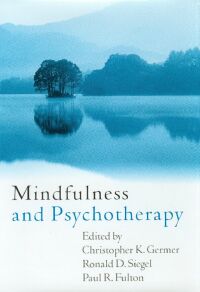 I remember the first time I observed Larry Vaughan lead a group therapy session. We were both working at a psychiatric treatment center for adolescents, a place we affectionately referred to as the “Island of Misfit Toys.” As the new guy on staff, my role was to take care of as much paperwork and annoying administrative tasks as possible, so that Larry and the other seasoned pros could focus on what they do best — help these kids deal with their problems. Larry was going over a little assignment he had given the kids earlier in the week. They were asked to write the entire story of their lives in exactly 28 words. One at a time each kid would read their stories and, for the most part, they would stick to surface stuff, like where they were born and where they went to school. Larry crumpled up the first few of these and tossed them in the trash can next to him. Eventually the kids got the picture. Larry was looking for something deep, something from the heart. All but one of the remaining kids crumpled up their own stories and tossed them into the trash, realizing their half-hearted efforts weren’t going to cut it in this group. They were about ready to head back to their rooms to give the assignment another shot when a 12 year old girl — the youngest of the group and the only one not to toss her story — asked if she could share her 28 words. I don’t remember what the words were, but I do remember the lump in my throat and the tears welling in my eyes. Larry just nodded his head, and maybe cracked a smile. By the end of the evening I would hear many more 28 Word Life Stories that came straight from the heart, not a word wasted.
I remember the first time I observed Larry Vaughan lead a group therapy session. We were both working at a psychiatric treatment center for adolescents, a place we affectionately referred to as the “Island of Misfit Toys.” As the new guy on staff, my role was to take care of as much paperwork and annoying administrative tasks as possible, so that Larry and the other seasoned pros could focus on what they do best — help these kids deal with their problems. Larry was going over a little assignment he had given the kids earlier in the week. They were asked to write the entire story of their lives in exactly 28 words. One at a time each kid would read their stories and, for the most part, they would stick to surface stuff, like where they were born and where they went to school. Larry crumpled up the first few of these and tossed them in the trash can next to him. Eventually the kids got the picture. Larry was looking for something deep, something from the heart. All but one of the remaining kids crumpled up their own stories and tossed them into the trash, realizing their half-hearted efforts weren’t going to cut it in this group. They were about ready to head back to their rooms to give the assignment another shot when a 12 year old girl — the youngest of the group and the only one not to toss her story — asked if she could share her 28 words. I don’t remember what the words were, but I do remember the lump in my throat and the tears welling in my eyes. Larry just nodded his head, and maybe cracked a smile. By the end of the evening I would hear many more 28 Word Life Stories that came straight from the heart, not a word wasted.
For the next three and a half years I would have the great privilege of observing Larry’s masterful therapy work at least one evening per week. It was like going to graduate school for free, and I consider my time on the Island of Misfit Toys to be one of the most profound learning experiences of my life. When I heard Larry had written a book, I couldn’t wait to get my hands on it. It’s a collection of short essays and personal stories called Tell Me How You Feel About That: Things I think I know about therapy and life, and it’s an absolute gem. Here’s what he has to say after describing the “28 Word Life Story” assignment:
There are rooms hidden deep inside you. Rooms that you have long since kept locked and dark. It takes an ingrown eye to find this place. And more than a few sheets of paper.
Like the stories that stay out of his trash can, Larry wastes not a word as he reflects on his life and life’s work. He writes in a smooth, conversational style that is totally unencumbered by pretense. Simple, straightforward prose that is also amazingly good writing. Whether or not you’re an aspiring therapist, you will find yourself at turns nodding your head, smiling, tearing up, and laughing out loud. On a personal level, Larry offers us the best of himself in this book. He’s explored many a deep, dark room — in his own life and while guiding others. Using his considerable gifts as a communicator, he’s sharing his most profound discoveries. I don’t know anyone who wouldn’t relate to, connect with, and/or feel moved by something in each of these intimate reflections.
For those of us who are in the helping professions or aspire to be, this book is simply a “must-read”, because it gives us what text books and/or graduate school, in and of themselves, could never deliver — that intangible, messy, mysterious, in-context, human element of therapy that makes it (at least) as much an art form as it is an application of learned technique. The dynamics of human relationships are notoriously hard to pin down. Understanding them and working with them to help others (and ourselves) requires an attitude of openminded, open-hearted curiosity — an attitude that Larry embodies in his work and in this book. This is what I appreciate most about Tell Me How You Feel About That: It’s not merely about the value of deep, authentic, from-the-heart self-exploration and expression — it is also a living, breathing example of it.
This is also what I appreciate most about Larry. Check out his book. You’ll love it!

 I’m currently reading Mindfulness and Psychotherapy (Edited by Germer, Siegel & Fulton), widely considered to be one the best books yet published on the topic. Four chapters in, and I’m enjoying the book thoroughly. I just came across a section on the value of cultivating empathy through Buddhist-inspired practice. I like the image the authors (Susan & William Morgan) use to connect intention, practice, and whatever sought-after quality one is trying to cultivate (in this case, empathy):
I’m currently reading Mindfulness and Psychotherapy (Edited by Germer, Siegel & Fulton), widely considered to be one the best books yet published on the topic. Four chapters in, and I’m enjoying the book thoroughly. I just came across a section on the value of cultivating empathy through Buddhist-inspired practice. I like the image the authors (Susan & William Morgan) use to connect intention, practice, and whatever sought-after quality one is trying to cultivate (in this case, empathy):

 I remember the first time I observed Larry Vaughan lead a group therapy session. We were both working at a psychiatric treatment center for adolescents, a place we affectionately referred to as the “Island of Misfit Toys.” As the new guy on staff, my role was to take care of as much paperwork and annoying administrative tasks as possible, so that Larry and the other seasoned pros could focus on what they do best — help these kids deal with their problems. Larry was going over a little assignment he had given the kids earlier in the week. They were asked to write the entire story of their lives in exactly 28 words. One at a time each kid would read their stories and, for the most part, they would stick to surface stuff, like where they were born and where they went to school. Larry crumpled up the first few of these and tossed them in the trash can next to him. Eventually the kids got the picture. Larry was looking for something deep, something from the heart. All but one of the remaining kids crumpled up their own stories and tossed them into the trash, realizing their half-hearted efforts weren’t going to cut it in this group. They were about ready to head back to their rooms to give the assignment another shot when a 12 year old girl — the youngest of the group and the only one not to toss her story — asked if she could share her 28 words. I don’t remember what the words were, but I do remember the lump in my throat and the tears welling in my eyes. Larry just nodded his head, and maybe cracked a smile. By the end of the evening I would hear many more 28 Word Life Stories that came straight from the heart, not a word wasted.
I remember the first time I observed Larry Vaughan lead a group therapy session. We were both working at a psychiatric treatment center for adolescents, a place we affectionately referred to as the “Island of Misfit Toys.” As the new guy on staff, my role was to take care of as much paperwork and annoying administrative tasks as possible, so that Larry and the other seasoned pros could focus on what they do best — help these kids deal with their problems. Larry was going over a little assignment he had given the kids earlier in the week. They were asked to write the entire story of their lives in exactly 28 words. One at a time each kid would read their stories and, for the most part, they would stick to surface stuff, like where they were born and where they went to school. Larry crumpled up the first few of these and tossed them in the trash can next to him. Eventually the kids got the picture. Larry was looking for something deep, something from the heart. All but one of the remaining kids crumpled up their own stories and tossed them into the trash, realizing their half-hearted efforts weren’t going to cut it in this group. They were about ready to head back to their rooms to give the assignment another shot when a 12 year old girl — the youngest of the group and the only one not to toss her story — asked if she could share her 28 words. I don’t remember what the words were, but I do remember the lump in my throat and the tears welling in my eyes. Larry just nodded his head, and maybe cracked a smile. By the end of the evening I would hear many more 28 Word Life Stories that came straight from the heart, not a word wasted.